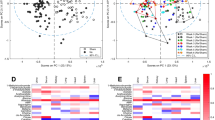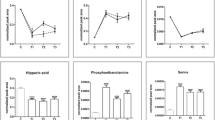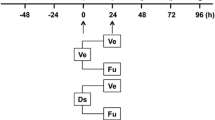Abstract
LC/MS- and NMR-based global metabolomics analyses were utilized to study the changes in rat urine in response to gentamicin treatment. Sprague–Dawley rats were dosed with gentamicin sulfate at 0, 75, 150 or 300 mg/kg/day for one, two or three consecutive days. Four animals from each group were sacrificed to harvest kidney tissue and to collect urine on days 1, 2, 3, 7, 10, 15, 18, 22, 29, 36 and 44 for a total of 11 different time points. Both uni- and multivariate statistical analyses were employed to identify the significantly changed metabolites in urine at the different dose levels and time points. Increases and decreases in amino acids including tyrosine, valine and hydroxyproline reflected histopathology changes of kidney injury development and/or kidney injury recovery. Glucosuria was noted much earlier than changes in the classic kidney function biomarkers, blood urea nitrogen and serum creatinine. Dopamine-related compounds, homovanillic acid sulfate (HVA-SO4) and homoveratric acid sulfate (HVrA-SO4) were significantly increased at early time points and could be early indicators of a renal adaptive response to gentamicin-induced renal injury. Furthermore, the drug efficacy of gentamicin was evaluated through the detection of changes in gut microflora-related compounds (e.g. indole-containing metabolites). Metabolomics was successful in identifying valine, hydroxyproline, HVA-SO4 and HVrA-SO4 that might serve as potential early injury biomarkers or adaptive markers of gentamicin-induced renal injury, and in assessing gentamicin efficacy through changes in compounds reported to be related to gut microflora. However, caution should be taken in direct translation of the biomarkers reported in clinical settings because a much higher dose of gentamicin than the normal therapeutic dose (~1–2 mg/kg) was used to cause kidney damaged.







Similar content being viewed by others
References
Arzuaga, X., Rieth, S. H., Bathija, A., & Cooper, G. S. (2010). Renal effects of exposure to natural and depleted uranium: a review of the epidemiologic and experimental data. Journal of Toxicology and Environmental Health Part B, 13, 527–545.
Beger, R. D., Holland, R. D., Sun, J., Schnackenberg, L. K., Moore, P. C., Dent, C. L., et al. (2008). Metabonomics of acute kidney injury in children after cardiac surgery. Pediatric Nephrology (Berlin, Germany), 23, 977–984.
Bennett, W. M., Mela-Riker, L. M., Houghton, D. C., Gilbert, D. N., & Buss, W. C. (1988). Microsomal protein synthesis inhibition: An early manifestation of gentamicin nephrotoxicity. American Journal of Physiology, 255, F265–F269.
Bone, E., Tamm, A., & Hill, M. (1976). The production of urinary phenols by gut bacteria and their possible role in the causation of large bowel cancer. American Journal of Clinical Nutrition, 29, 1448–1454.
Boudonck, K. J., Mitchell, M. W., Német, L., Keresztes, L., Nyska, A., Shinar, D., et al. (2009). Discovery of metabolomics biomarkers for early detection of nephrotoxicity. Toxicologic Pathology, 37, 280–292.
Conger, J. D., Falk, S. A., & Hammond, W. S. (1991). Atrial natriuretic peptide and dopamine in established acute renal failure in the rat. Kidney International, 40, 21–28.
Davis, J. W., & Kramer, J. A. (2006). Genomic-based biomarkers of drug-induced nephrotoxicity. Expert Opinion on Drug Metabolism and Toxicology, 2, 95–101.
Dieterle, F., Sistare, F., Goodsaid, F., Papaluca, M., Ozer, J. S., Webb, C. P., et al. (2010). Renal biomarker qualification submission: A dialog between the FDA-EMEA and Predictive Safety Testing Consortium. Nature Biotechnology, 28, 455–462.
Duarte, C. G., & Preuss, H. G. (1993). Assessment of renal function—glomerular and tubular. Clinics in Laboratory Medicine, 13, 33–52.
Emeigh, S., & Kinter, L. (2005). Assessing renal effects of toxicants in vitro. In J. Tarloff & L. Lash (Eds.), Toxicology of the kidney (3rd ed., pp. 81–147). Washington, DC: CRC Press.
Espandiari, P., Zhang, J., Rosenzweig, B. A., Vaidya, V. S., Sun, J., Schnackenberg, L. K., et al. (2007). The utility of a rodent model in detecting pediatric drug-induced nephrotoxicity. Toxicological Sciences, 99, 637–648.
Espandiari, P., Zhang, J., Schnackenberg, L. K., Miller, T. J., Knapton, A., Herman, E. H., et al. (2008). Age-related differences in susceptibility to toxic effects of valproic acid in rats. Journal of Applied Toxicology, 28, 628–637.
Faiz, H., Conjard-Duplany, A., Boghossian, M., Martin, G., Baverel, G., & Ferrier, B. (2011). Cadmium chloride inhibits lactate gluconeogenesis in isolated human renal proximal tubules: A cellular metabolomic approach with (13)C-NMR. Archives of Toxicology, 85, 1067–1077.
Gare, M., Haviv, Y. S., Ben-Yehuda, A., Rubinger, D., Bdolah-Abram, T., Fuchs, S., et al. (1999). The renal effect of low-dose dopamine in high-risk patients undergoing coronary angiography. Journal of the American College of Cardiology, 34, 1682–1688.
Goodsaid, F., & Frueh, F. W. (2007). Biomarker qualification pilot process at the US Food and Drug Administration. AAPS Journal, 9, E105–E108.
Goodsaid, F. M., Frueh, F. W., & Mattes, W. (2008). Strategic paths for biomarker qualification. Toxicology, 245, 219–223.
Jernberg, C., Löfmark, S., Edlund, C., & Jansson, J. K. (2007). Long-term ecological impacts of antibiotic administration on the human intestinal microbiota. ISME Journal, 1, 56–66.
Kim, K. B., Um, S. Y., Chung, M. W., Jung, S. C., Oh, J. S., Kim, S. H., et al. (2010). Toxicometabolomics approach to urinary biomarkers for mercuric chloride (HgCl2)-induced nephrotoxicity using proton nuclear magnetic resonance (¹H NMR) in rats. Toxicology and Applied Pharmacology, 249, 114–126.
Lee, M. R. (1993). Dopamine and the kidney: Ten years on. Clinical Science, 84, 357–375.
Lenz, E. M., Bright, J., Knight, R., Wilson, I. D., & Major, H. (2004a). Cyclosporin A-induced changes in endogenous metabolites in rat urine: A metabonomic investigation using high field 1H NMR spectroscopy, HPLC-TOF/MS and chemometrics. Journal of Pharmaceutical and Biomedical Analysis, 35, 599–608.
Lenz, E. M., Bright, J., Knight, R., Wilson, I. D., & Major, H. (2004b). A metabonomic investigation of the biochemical effects of mercuric chloride in the rat using 1H NMR and HPLC-TOF/MS: Time dependent changes in the urinary profile of endogenous metabolites as a result of nephrotoxicity. Analyst, 129, 535–541.
Lenz, E. M., Bright, J., Knight, R., Westwood, F. R., Davies, D., Major, H., et al. (2005). Metabonomics with 1H-NMR spectroscopy and liquid chromatography-mass spectrometry applied to the investigation of metabolic changes caused by gentamicin-induced nephrotoxicity in the rat. Biomarkers, 10, 173–187.
Ling, X. B., Sigdel, T. K., Lau, K., Ying, L., Lau, I., Schilling, J., et al. (2010). Integrative urinary peptidomics in renal transplantation identifies biomarkers for acute rejection. Journal of the American Society of Nephrology, 21, 646–653.
Lv, H., Liu, L., Zhang, Y., Song, T., Lu, J., & Chen, X. (2010). Ingenuity pathways analysis of urine metabonomics phenotypes toxicity of gentamicin in multiple organs. Molecular Biosystems, 6, 2056–2067.
Macpherson, N. A., Moscarello, M. A., & Goldberg, D. M. (1991). Aminoaciduria is an earlier index of renal tubular damage than conventional renal disease markers in the gentamicin-rat model of acute renal failure. Clinical and Investigative Medicine, 14, 101–110.
Mitsui, G., Dote, T., Yamadori, E., Imanishi, M., Nakayama, S., Ohnishi, K., et al. (2010). Toxicokinetics and metabolism deteriorated by acute nephrotoxicity after a single intravenous injection of hydrofluoric acid in rats. Journal of Occupational Health, 52, 395–399.
Nicholson, J. K., Holmes, E., & Wilson, I. D. (2005). Gut microorganisms, mammalian metabolism and personalized health care. Nature Reviews Microbiology, 3, 431–438.
Portilla, D., Li, S., Nagothu, K. K., Megyesi, J., Kaissling, B., Schnackenberg, L. K., et al. (2006). Metabolomic study of cisplatin-induced nephrotoxicity. Kidney International, 69, 2194–2204.
Price, R. G. (1992). The role of NAG (N-acetyl-beta-d-glucosaminidase) in the diagnosis of kidney disease including the monitoring of nephrotoxicity. Clinical Nephrology, 38, S14–S19.
Rouse, R. L., Zhang, J., Stewart, S. R., Rosenzweig, B. A., Espandiari, P., & Sadrieh, N. K. (2011). Comparative profile of commercially available urinary biomarkers in preclinical drug-induced kidney injury and recovery in rats. Kidney International, 79, 1186–1197.
Sangster, T., Major, H., Plumb, R., Wilson, A. J., & Wilson, I. D. (2006). A pragmatic and readily implemented quality control strategy for HPLC-MS and GC-MS-based metabonomic analysis. Analyst, 131, 1075–1078.
Shimada, M., Terazawa, R., Kamiyama, Y., Honma, W., Nagata, K., & Yamazoe, Y. (2004). Unique properties of a renal sulfotransferase, St1d1, in dopamine metabolism. Journal of Pharmacology and Experimental Therapeutics, 310, 808–814.
Smith, E. A., & Macfarlane, G. T. (1996). Enumeration of human colonic bacteria producing phenolic and indolic compounds: Effects of pH, carbohydrate availability and retention time on dissimilatory aromatic amino acid metabolism. Journal of Applied Bacteriology, 81, 288–302.
Smith, C. A., Want, E. J., O’Maille, G., Abagyan, R., & Siuzdak, G. (2006). XCMS: Processing mass spectrometry data for metabolite profiling using nonlinear peak alignment, matching, and identification. Analytical Chemistry, 78, 779–787.
Tayebati, S. K., Lokhandwala, M. F., & Amenta, F. (2011). Dopamine and vascular dynamics control: Present status and future perspectives. Current Neurovascular Research, 8, 246–257.
Turnbaugh, P. J., Ley, R. E., Mahowald, M. A., Magrini, V., Mardis, E. R., & Gordon, J. I. (2006). An obesity-associated gut microbiome with increased capacity for energy harvest. Nature, 444, 1027–1031.
Turnbaugh, P. J., Bäckhed, F., Fulton, L., & Gordon, J. I. (2008). Diet-induced obesity is linked to marked but reversible alterations in the mouse distal gut microbiome. Cell Host and Microbe, 17, 213–223.
van de Poll, M. C., Soeters, P. B., Deutz, N. E., Fearon, K. C., & Dejong, C. H. (2004). Renal metabolism of amino acids: Its role in interorgan amino acid exchange. American Journal of Clinical Nutrition, 79, 185–197.
Werner, M., Costa, M. J., Mitchell, L. G., & Nayar, R. (1995). Nephrotoxicity of xenobiotics. Clinica Chimica Acta, 237, 107–154.
Wikoff, W. R., Anfora, A. T., Liu, J., Schultz, P. G., Lesley, S. A., Peters, E. C., et al. (2009). Metabolomics analysis reveals large effects of gut microflora on mammalian blood metabolites. Proceedings of the National Academy of Sciences of USA, 106, 3698–3703.
Wolfovitz, E., Grossman, E., Folio, C. J., Keiser, H. R., Kopin, I. J., & Goldstein, D. S. (1993). Derivation of urinary dopamine from plasma dihydroxyphenylalanine in humans. Clinical Science, 84, 549–557.
Zhang, J., Goering, P. G., Espandiari, P., Shaw, M., Bonventre, J. V., Vaidya, V. S., et al. (2009). Differences in immunolocalization of Kim-1, RPA-1, and RPA-2 in kidneys of gentamicin-, cisplatin-, and valproic acid-treated rats: Potential role of iNOS and nitrotyrosine. Toxicologic Pathology, 37, 629–643.
Acknowledgments
The findings and conclusions in this article have not been formally disseminated by the Food and Drug Administration and should not be construed to represent any Agency determination or policy.
Author information
Authors and Affiliations
Corresponding author
Electronic supplementary material
Below is the link to the electronic supplementary material.
Rights and permissions
About this article
Cite this article
Sun, J., Bhattacharyya, S., Schnackenberg, L.K. et al. Discovery of early urinary biomarkers in preclinical study of gentamicin-induced kidney injury and recovery in rats. Metabolomics 8, 1181–1193 (2012). https://doi.org/10.1007/s11306-012-0423-7
Received:
Accepted:
Published:
Issue Date:
DOI: https://doi.org/10.1007/s11306-012-0423-7




